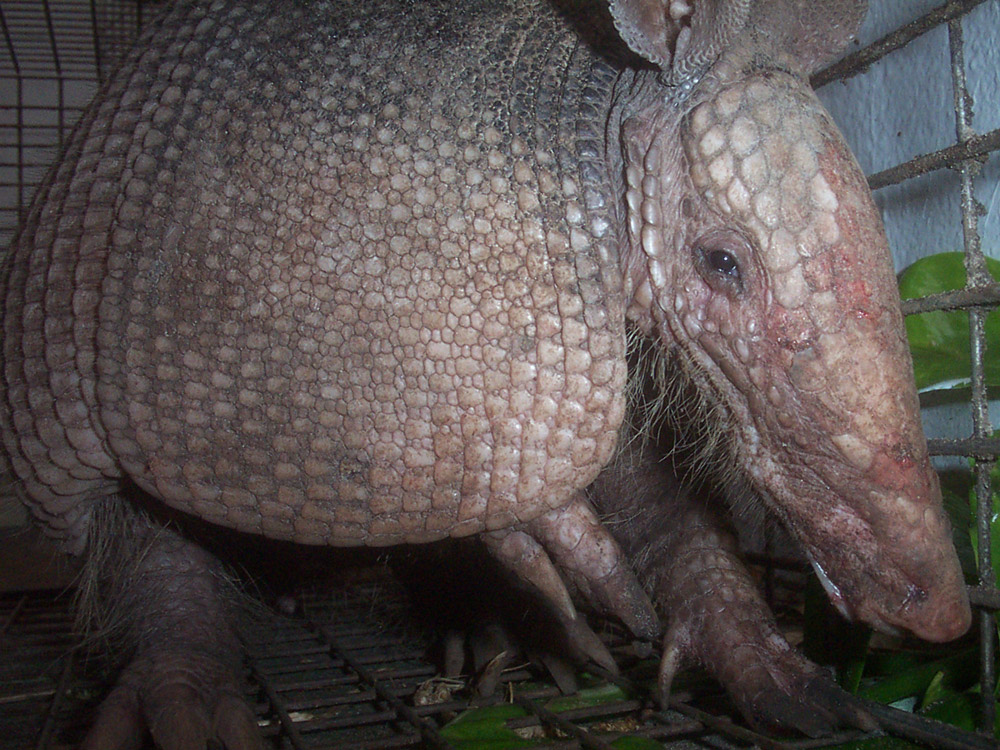

Greater naked-tailed armadillo, Cabassous tatouay.Southern naked-tailed armadillo, Cabassous unicinctus.Chacoan naked-tailed armadillo, Cabassous chacoensis.Northern naked-tailed armadillo, Cabassous centralis.Other various vernacular names given are: The Portuguese word for "armadillo" is tatu which is derived from the Tupi language ta' "bark, armor" and tu "dense" and used in Argentina, Bolivia, Brasil, Paraguay and Uruguay similar names are also found in other, especially European, languages. The Aztecs called them āyōtōchtli, Nahuatl for "turtle-rabbit": āyōtl (turtle) and tōchtli (rabbit). While the phrase "little armored one" would translate to "armadito" normally, the suffix "-illo" can be used in place of "-ito" when the diminutive is used in an approximative tense. The word armadillo means "little armored one" in Spanish it is derived from "armadura" (armor), with the diminutive suffix "-illo" attached. When threatened by a predator, Tolypeutes species frequently roll up into a ball they are the only species of armadillo capable of this. The giant armadillo grows up to 150 cm (59 in) and weighs up to 54 kg (119 lb), while the pink fairy armadillo has a length of only 13–15 cm (5–6 in). The average length of an armadillo is about 75 cm (30 in), including its tail. They have short legs, but can move quite quickly. All species are native to the Americas, where they inhabit a variety of different environments.Īrmadillos are characterized by a leathery armor shell and long, sharp claws for digging. Nine extinct genera and 21 extant species of armadillo have been described, some of which are distinguished by the number of bands on their armor. The Chlamyphoridae and Dasypodidae are the only surviving families in the order, which is part of the superorder Xenarthra, along with the anteaters and sloths. " Dasypus novemcinctus (Nine-Banded Armadillo)." Animal Diversity Web.Armadillos (meaning "little armored ones" in Spanish) are New World placental mammals in the order Cingulata. " Hibernation and Daily Torpor in an Armadillo, the Pichi ( Zaedyus pichiy)." Comparative Biochemistry and Physiology Part A: Molecular & Integrative Physiology, vol.

" On the Age of Leprosy." PLoS Neglected Tropical Diseases, vol. " Time Budgets of Wild Nine-Banded Armadillos." Southeastern Naturalist, vol. “ Gliptodontes y Cazadores-Recolectores De La Region Pampeana (Argentina).” Latin American Antiquity, vol. " Mysterious Extinct Glyptodonts Are Actually Gigantic Armadillos, Says Their DNA." American Museum of Natural History. Miranda, F., et al. " Brazilian Three-banded Armadillo: Tolypeutes tricinctus." IUCN Red List, 2014, e.T21975A47443455., doi:10.2305/IUCN.UK. " Brazilian Three-Banded Armadillo." Xenarthrans. " How High Can A Nine-Banded Armadillo Jump?" The Library of Congress. " Taxonomic Revision of the Dasypus kappleri Complex, With Revalidations of Dasypus pastasae (Thomas, 1901) and Dasypus beniensis Lönnberg, 1942 (Cingulata, Dasypodidae)." Zootaxa, vol. Feijó, Anderson, and Cordeiro-Estrela, Pedro.


 0 kommentar(er)
0 kommentar(er)
